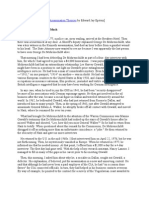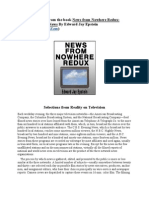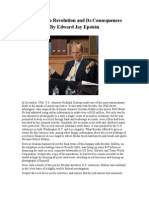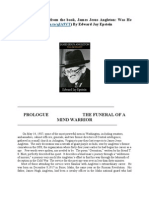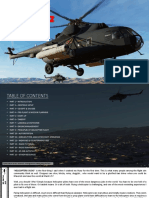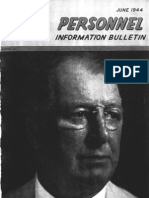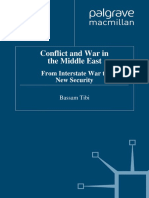Professional Documents
Culture Documents
Killing Castro by Edward Jay Epstein
Uploaded by
edepsteinOriginal Description:
Copyright
Available Formats
Share this document
Did you find this document useful?
Is this content inappropriate?
Report this DocumentCopyright:
Available Formats
Killing Castro by Edward Jay Epstein
Uploaded by
edepsteinCopyright:
Available Formats
This an excerpt from the book Killing Castro By Edward Jay Epstein (http://amzn.
to/rijsWc)
[1] The Day of the Two Jackals
November 22, 1963. Even as the open limousine carrying President John F. Kennedy was moving into the cross-hairs of Lee Harvey Oswalds telescopic sights in Dallas, a high-ranking CIA official in Paris, representing himself as the emissary of Attorney General Robert Kennedy, was delivering to a Cuban assassin the weapons to kill Castro. So there were two different assassins in two different cities with two different targets. The assassin in Paris was Major Rolando Cubela, a close associate of Fidel Castro. In 1961, he had Cubela boldly approached by a CIA officer, identified himself, and then offered to act as a secret CIA operative inside Cuba. The CIA determined from its data bank that, despite his brashness, he had possibilities. He had been a close associate of Castros, headed Castros International Federation of Students, and he was allowed to go abroad to attend international meetings. On July 30th 1962, during an international conference in Helsinki, Finland, he met with another CIA and again offered his services. Specifically, according the CIAs Inspector Generals Report on Plots to Assassinate Castro, he offered to execute Carlos Rodriguez, who was one of Castros key operatives. The CIA gave him the codename AMLASH, and offered him a lie detector test, which is standard procedure in the recruitment of walk-ins. In Washington, the CIA Directorate of Plans, which was under pressure after the failure of the CIA-sponsored Bay of Pigs invasion, carefully weighed his offer. If it was legitimate, the CIA had finally found an assassin who could get to the Castros inner circle. But on August 18, 1962, when AMLASH refused to take a lie detector test, Richard Helms, then head of the Directorate of Plans, put the mission on ice, instructing in a cable that AMLASH was not to be used for a physical elimination missions (which was then the CIAs euphemism for assassination.)
By September 1963, however, after a CIA-sponsored coup detat against Castro failed to materialize, the CIA, and Helms in particular, came under increasing pressure from President Kennedy and Attorney-General to take action against Castro. Richard Helms said he could feel "white heat" from the Kennedys. So he allowed AMLASH to be reactivated. In early September, AMLASH was representing Castro at the Pan American Games in Port Alegre, Brazil. The CIA dispatched Nestor Sanchez there to ask him if he was willing to carry out an elimination mission aimed at Castro. AMLASH said he would carry it out on one condition: he wanted a personal meeting with a high-ranking official of the Kennedy Administration. He said this meeting was necessary because he wanted to make certain that President Kennedy had authorized this move against Castro. As extraordinary as this request was, Desmond FitzGerald, chief of the CIAs covert unit responsible for orchestrating the overthrow of Castro, decided that as a friend of Attorney General Robert Kennedy, he would go to meet the assassin. While top-ranking executives of the CIA usually did not meet operatives, he decided it was worth the risk. The contact plan for the meeting stated: "FitzGerald will represent himself as personal representative of Robert F. Kennedy who traveled to [Paris] for specific purpose of meeting AMLASH and giving him assurances of full support with the change of the present government." Even though Fitzgerald used the alias James Clark, he was physically recognizable from press photographs as a social friend in the Kennedy circle. The meeting took place in a hotel room in Paris on October 29, 1963. Fitzgerald was accompanied by Nestor Sanchez, who wrote in his report "Fitzgerald informed Cubela that the United States is prepared to render all necessary assistance to any anti-communist Cuban group which succeeds in neutralizing the present Cuban leadership. They discussed, in this regard, eliminating Castro. AMLASH asked for a high-powered rifle with a telescopic sight the same type weapon Oswald would use 23 days later in Dallas but Fitzgerald told him the CIA would provide a safer weapon. After that meeting, Fitzgerald authorized Sanchez to supply Amlash with a weapon that would provide better deniability. It was a papermate ballpoint pen with one hidden enhancement: a tiny needle that release a lethal toxin. The poison, Blackleaf 40, could be either injected into a beverage Castro might drink or, as it was transdermal, it could be put on an object that Castro might touch. AMLASH, after surreptitiously administering the poison, would discard the pen. Meanwhile, the CIA's counterintelligence staff, under the legendary James Jesus Angleton, developed serious concerns about AMLASH's provenance. Angleton, as he later told me, could not accept that it was merely a coincidence that, first, AMLASH is reactivated in Brazil for a mission to assassinate Castro in Brazil, and, only a day or so later, Castro goes to Brazilian territory, the embassy of Brazil in Havana, to tell an American AP reporter that he knew the American government was behind plots to kill him. If it was not a coincidence, then Castro knew about the meeting in Brazil. In Angletons parallax universe of deception, it was a distinct possibility that AMLASH was an agent provocateur, who Castro dangled to the CIA to ascertain if President Kennedy had authorized his assassination. The danger was clear to Angleton: By working with Cubela, Fitzgerald could give Castro evidence of the involvement of the highest echelon of American government in the assassination plot. He warned Fitzgerald that he considered the operation insecure, and suggested it be terminated. But it was too late. To further convince the AMLASH that the President had authorized the
elimination of Castro, Fitzgerald wrote a "signal" into a Presidential speech, a phrase that described the Castro regime as a "small band of conspirators" that needed to be "removed." When President Kennedy himself delivered those very words in a speech in Miami on November 18th AMLASH, would have his proof that Fitzgerald was close enough to the President to insert words in his speech. And, if AMLASH was a double agent, as Angleton suspected, Castro would also have his proof. The next meeting took place in Paris on November 22nd 1963. Sanchez handed over the assassination pen to AMLASH, and was instructing him how the Blackleaf 40 poison could be obtained in Havana. Suddenly, the meeting was interrupted by an urgent message: President Kennedy had been assassinated in Dallas. The AMLASH mission was aborted. So ended the CIA's futile assassination attempts against Castro. This chapter is excerpted from Edward Jay Epsteins book Killing Castro, now available on Kindle (http://amzn.to/rijsWc) and Kindle apps for ipad. It is also available on Nook (http://bit.ly/nHO4NI)) and the itunes Store. Other books by Edward Jay Epstein can be found at: (http://amzn.to/ndfiNf)
Killing Castro By Edward Jay Epstein Other Books By Edward Jay Epstein Inquest Legend News From Nowhere Cartel The Rise and Fall of Diamonds Agency of Fear Between Fact and Fiction The Assassination Chronicles The Big Picture The Hollywood Economist Myths of the Media EJE Originals
Armand Hammer: The Darker Side The Rockefellers The JFK Assassination Theories Garrisons Game Zias Crash Who Killed Gods Banker Tabloid America: Crimes of the Press Killing Castro James Jesus Angleton: Was He Right? The Money Demons: True Fables of Wall Street
Copyright by EJE Publication 2011 All Rights Reserved ISBN 978-1-61704-077-1 Cover Design by J. Elissa Marshal About The Author Edward Jay Epstein studied government at Cornell and Harvard, receiving his Ph.D. from Harvard in 1973. His master's thesis at Cornell was published as Inquest: The Warren Commission and the Establishment of Truth and became a national best seller; his doctoral dissertation at Harvard was published as News From Nowhere: The Selection of Reality on Television, and is today a standard textbook in media studies courses . He taught political science at MIT and UCLA before becoming a full time author. He lives in New York City. His website is www.edwardjayepstein.com
You might also like
- The Man Who Knew Too Much: The JFK Assassination TheoriesDocument4 pagesThe Man Who Knew Too Much: The JFK Assassination TheoriesedepsteinNo ratings yet
- Demonizing Goldman Klone 2 WORDDocument4 pagesDemonizing Goldman Klone 2 WORDedepsteinNo ratings yet
- News From Nowhere Redux: Television and The News by Edward Jay EpsteinDocument6 pagesNews From Nowhere Redux: Television and The News by Edward Jay EpsteinedepsteinNo ratings yet
- The Milken Revolution and Its ConsequencesDocument15 pagesThe Milken Revolution and Its ConsequencesedepsteinNo ratings yet
- James Jesus Angleton: Was He Right by Edward Jay EpsteinDocument7 pagesJames Jesus Angleton: Was He Right by Edward Jay EpsteinedepsteinNo ratings yet
- Scribble First ChapterDocument15 pagesScribble First ChapteredepsteinNo ratings yet
- The Subtle Art of Not Giving a F*ck: A Counterintuitive Approach to Living a Good LifeFrom EverandThe Subtle Art of Not Giving a F*ck: A Counterintuitive Approach to Living a Good LifeRating: 4 out of 5 stars4/5 (5783)
- The Yellow House: A Memoir (2019 National Book Award Winner)From EverandThe Yellow House: A Memoir (2019 National Book Award Winner)Rating: 4 out of 5 stars4/5 (98)
- Never Split the Difference: Negotiating As If Your Life Depended On ItFrom EverandNever Split the Difference: Negotiating As If Your Life Depended On ItRating: 4.5 out of 5 stars4.5/5 (838)
- Shoe Dog: A Memoir by the Creator of NikeFrom EverandShoe Dog: A Memoir by the Creator of NikeRating: 4.5 out of 5 stars4.5/5 (537)
- The Emperor of All Maladies: A Biography of CancerFrom EverandThe Emperor of All Maladies: A Biography of CancerRating: 4.5 out of 5 stars4.5/5 (271)
- Hidden Figures: The American Dream and the Untold Story of the Black Women Mathematicians Who Helped Win the Space RaceFrom EverandHidden Figures: The American Dream and the Untold Story of the Black Women Mathematicians Who Helped Win the Space RaceRating: 4 out of 5 stars4/5 (890)
- The Little Book of Hygge: Danish Secrets to Happy LivingFrom EverandThe Little Book of Hygge: Danish Secrets to Happy LivingRating: 3.5 out of 5 stars3.5/5 (399)
- Team of Rivals: The Political Genius of Abraham LincolnFrom EverandTeam of Rivals: The Political Genius of Abraham LincolnRating: 4.5 out of 5 stars4.5/5 (234)
- Grit: The Power of Passion and PerseveranceFrom EverandGrit: The Power of Passion and PerseveranceRating: 4 out of 5 stars4/5 (587)
- Devil in the Grove: Thurgood Marshall, the Groveland Boys, and the Dawn of a New AmericaFrom EverandDevil in the Grove: Thurgood Marshall, the Groveland Boys, and the Dawn of a New AmericaRating: 4.5 out of 5 stars4.5/5 (265)
- A Heartbreaking Work Of Staggering Genius: A Memoir Based on a True StoryFrom EverandA Heartbreaking Work Of Staggering Genius: A Memoir Based on a True StoryRating: 3.5 out of 5 stars3.5/5 (231)
- On Fire: The (Burning) Case for a Green New DealFrom EverandOn Fire: The (Burning) Case for a Green New DealRating: 4 out of 5 stars4/5 (72)
- Elon Musk: Tesla, SpaceX, and the Quest for a Fantastic FutureFrom EverandElon Musk: Tesla, SpaceX, and the Quest for a Fantastic FutureRating: 4.5 out of 5 stars4.5/5 (474)
- The Hard Thing About Hard Things: Building a Business When There Are No Easy AnswersFrom EverandThe Hard Thing About Hard Things: Building a Business When There Are No Easy AnswersRating: 4.5 out of 5 stars4.5/5 (344)
- The Unwinding: An Inner History of the New AmericaFrom EverandThe Unwinding: An Inner History of the New AmericaRating: 4 out of 5 stars4/5 (45)
- The World Is Flat 3.0: A Brief History of the Twenty-first CenturyFrom EverandThe World Is Flat 3.0: A Brief History of the Twenty-first CenturyRating: 3.5 out of 5 stars3.5/5 (2219)
- The Gifts of Imperfection: Let Go of Who You Think You're Supposed to Be and Embrace Who You AreFrom EverandThe Gifts of Imperfection: Let Go of Who You Think You're Supposed to Be and Embrace Who You AreRating: 4 out of 5 stars4/5 (1090)
- The Sympathizer: A Novel (Pulitzer Prize for Fiction)From EverandThe Sympathizer: A Novel (Pulitzer Prize for Fiction)Rating: 4.5 out of 5 stars4.5/5 (119)
- Her Body and Other Parties: StoriesFrom EverandHer Body and Other Parties: StoriesRating: 4 out of 5 stars4/5 (821)
- PistolBrochure 2011 V2Document56 pagesPistolBrochure 2011 V2José Manoel100% (1)
- Open Letter To The Philippine Congress From The Gov't and MILF Peace PanelsDocument3 pagesOpen Letter To The Philippine Congress From The Gov't and MILF Peace PanelsOffice of the Presidential Adviser on the Peace ProcessNo ratings yet
- Article Review of The Rise of Multipolarity, The Reshaping of Order: China in A Brave New World by Gerald ChanDocument5 pagesArticle Review of The Rise of Multipolarity, The Reshaping of Order: China in A Brave New World by Gerald ChanRiezqa WandaNo ratings yet
- Commercial Dispatch Eedition 3-12-18 PDFDocument12 pagesCommercial Dispatch Eedition 3-12-18 PDFThe DispatchNo ratings yet
- WWII 7th Armored DivisionDocument43 pagesWWII 7th Armored DivisionCAP History Library100% (3)
- Dictator Bo Ne Win and Bo Aung Gyi Destroyed Historic Students' Union BuildingDocument2 pagesDictator Bo Ne Win and Bo Aung Gyi Destroyed Historic Students' Union BuildingthakhinRITNo ratings yet
- Sir Alexander Cunningham: Founding the Archaeological Survey of IndiaDocument5 pagesSir Alexander Cunningham: Founding the Archaeological Survey of IndiaAakashParanNo ratings yet
- Dcs Mi-8mtv2 GuideDocument115 pagesDcs Mi-8mtv2 GuideCristianNo ratings yet
- Rhetorical SituationDocument13 pagesRhetorical SituationAugusto MelchiorNo ratings yet
- Israel-Palestine Solution ProposalDocument3 pagesIsrael-Palestine Solution Proposalapi-608098440No ratings yet
- How To Hear The Voice of God Secrets To Hearing Directly From God PDFDocument3 pagesHow To Hear The Voice of God Secrets To Hearing Directly From God PDFTonia Ngurang83% (6)
- The Dark Kin WQDocument13 pagesThe Dark Kin WQChris Williams100% (1)
- Battle of Traitors GorgeDocument1 pageBattle of Traitors GorgeReilly_Hayes_6103No ratings yet
- Valeros: STR DEX CON WIS INT CHADocument2 pagesValeros: STR DEX CON WIS INT CHAMatteo OlliverNo ratings yet
- A Case Study in Failed Planning: by Paul YoudeDocument12 pagesA Case Study in Failed Planning: by Paul Youdet1029No ratings yet
- Colonial Warbook IIDocument276 pagesColonial Warbook IIKendal Leask96% (26)
- The Future of WarsDocument28 pagesThe Future of WarsRachelLyeNo ratings yet
- All Hands Naval Bulletin - Jun 1944Document76 pagesAll Hands Naval Bulletin - Jun 1944CAP History Library100% (2)
- Gunbreaker - The HomebreweryDocument6 pagesGunbreaker - The HomebreweryNikos TsikinisNo ratings yet
- Barbarian Quick ReferenceDocument2 pagesBarbarian Quick ReferenceAnonymous FKfemeTNo ratings yet
- History of Philippine Government from Revolution to RepublicDocument25 pagesHistory of Philippine Government from Revolution to RepublicLeslie S. AndresNo ratings yet
- (Bassam Tibi (Auth.) ) Conflict and War in The Midd (B-Ok - Xyz) PDFDocument330 pages(Bassam Tibi (Auth.) ) Conflict and War in The Midd (B-Ok - Xyz) PDFOceanNo ratings yet
- The History of Irish Slavery in The AmericasDocument2 pagesThe History of Irish Slavery in The AmericasNuqman Tehuti El60% (5)
- Flag Hoist SignalingDocument36 pagesFlag Hoist Signalingqueen ann toledoNo ratings yet
- Richard III by Andrew MatthewsDocument36 pagesRichard III by Andrew MatthewsXuan Mai Nguyen ThiNo ratings yet
- Lod StringDocument9 pagesLod StringNeva h. MercyNo ratings yet
- First Shifting LIWORIZ Reviewer Part 2Document6 pagesFirst Shifting LIWORIZ Reviewer Part 2anonymousNo ratings yet
- Uss Milius Command Newslet Ter: F CO' DDocument8 pagesUss Milius Command Newslet Ter: F CO' DMilius CommandNo ratings yet
- Revisiting the Balangiga ConflictDocument32 pagesRevisiting the Balangiga ConflictShaina Mae EstudilloNo ratings yet
- Cadet Sea Training GuidelinesDocument9 pagesCadet Sea Training Guidelinessbdman100% (1)
